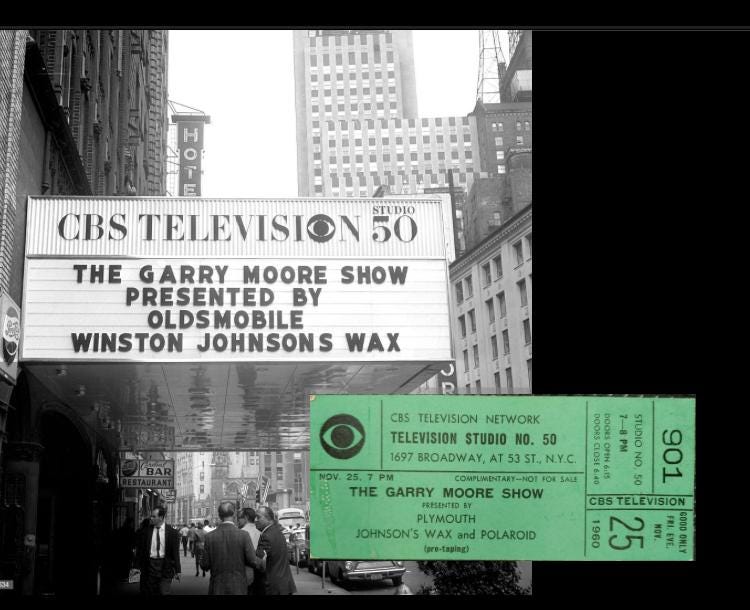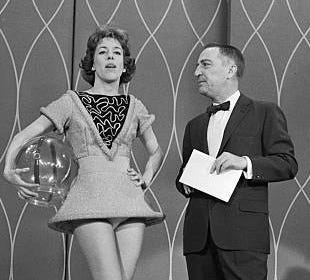"Once Upon This Mattress"
(Sixty-Five Years of Bold, Rampant, Unrepentant Shyness)
First, let me join in the chorus: the current Encores! production of Once Upon a Mattress is as great as they say - one of the most entertaining evenings I’ve ever spent in the theater. (My highly esteemed colleague at the New York Sun, Elysa Gardner, put it best here.). Sutton Foster is wonderful, and so is everybody else. Do whatever you can to get a ticket this weekend.
I thought I would take this opportunity to do a brief retrospective of Mattresses over the decades. And that title, “Once Upon This Mattress,” is not my invention, I actually did see that in an actor’s bio. (I can only take it to mean that said performer had appeared both in Once Upon a Mattress and Once On This Island.)
Let’s take a look at multiple versions of “Shy.” In the context of traditional musical theater, “Shy” can be viewed as the closest thing in Mattress to the expected “I Want” song, in which, early in the first or second scene, the leading lady tells us her hopes and dreams and what she wants out of life - the “I want” song is the key moment when we get to know the heroine, and find out what she’s all about.
“Princess Winifred” is both the embodiment of both the young Carol Burnett, a plucky, energetic youngster determined to succeed in the show business, and as, as Elysa observes, a stand in for composer Mary Rodgers herself. The great lady was very much a can-do kind of a gal who had a wide-ranging list of accomplishments in the worlds of music, theater, children’s literature, and philanthropy. Mrs. Guettel, as I always called her, obviously enjoyed the connection between herself and Winifred in that she titled her posthumously-published autobiography Shy, but it was subtitled the alarmingly outspoken memoirs of Mary Rodgers.
And that speaks to the duality of the song itself: in Marshall Barer’s lyrics, Winifred is telling us that she’s shy, but she’s belting it at the top of her lungs, and the song’s great humor - it’s a key moment in Act 1 - comes from the comic disconnect between what Winifred is telling us and what she’s actually showing us.
The earliest known footage comes from The Garry Moore Show of June 9, 1959, at the time when Carol Burnett was a regular on that series, and when Mattress was still running at the St. James Theater on 44th Street. (My buddy, Rob Waldman, attended a taping of the Garry Moore Show during the following season, and he still has the ticket! See above.)
This is as close as we get to the staging of the original production (which played at five different theaters between May 1959 and July 1960 for a total of 470 performances). We also get to a brief bit of Joe Bova as “Prince Dauntless the Drab,” who seems to have played the role as a kind of combination of Robert Morse in How to Succeed in Business Without Really Trying, and Frank Sinatra, Jr., in anything. (Even though neither of those cultural signposts, like long division, actually existed yet.) There’s also a line or two (“She swam the moat!”) from Jane White, daughter of the NAACP leader Walter White, as “Queen Aggravain,” a performance that goes down in history as one of the first examples on Broadway of an African American actress playing a character that wasn’t specifically Black. In another move then considered “progressive,” they cast Jack Gilford as “King Septimus the Silent,” a bold move in that he had barely worked in the last decade as a result of being victimized by the infamous Joseph McCarthy-era blacklist.
The 1964 television version of Mattress is by far the best - at least between 1960 and 2024. The screenwriters fiddled with the story and the songs, they created a character called “The Minstrel” (played by Bill Hayes, who died just a few days ago at the age of 98) who serves as the narrator, rather than “The Jester,” and who serves as Lady Larken’s leading man, rather than “Sir Harry.” Alas, they dropped “In a Little While,” but on the plus side, producer Joe Hamilton (then married to Burnett) and choreographer Joe Layton had the whole score re-orchestrated - and the pit band sounds much more lush and full than on the 1959 cast album.
“Man to Man Talk” has never been more funny and heart-warming than when performed by Joe Bova and the legendary Jack Gilford. As an added bonus, Elliott Gould (his debut on both film and TV) is the Jester, five years before he would climb on board another mattress in Bob & Carol & Ted & Alice. He gives us a great rendition of “Very Soft Shoes,” which I’ve always viewed as an homage to Ray Bolger and his iconic “The Old Soft Shoe” number in the 1946 revue Three to Make Ready. Another fun fact from Rob: “Michael Bennett is one of the dancers on ‘Shy.’ Carol has her arm around him near the end of the number.”
I always thought that the 1972 Once Upon a Mattress was the definitive production - that is, until I finally got to see the 1964 version The 1972 television show now seems to me like an extended comedy sketch from The Carol Burnett Show, even down to the laugh track, especially with Lyle Waggoner as a new character, “Sir Studley,” here a stand in for The Wizard as the Queen’s consort. Had they gone the traditional route with the Wizard character, Harvey Korman might have a been a natural for that part, and also Vicki Lawrence as Larken. (However, here Ron Husmann and Bernadette Peters are highlights as Harry and Larken.)
There’s nothing wrong with this version, only that compared to the 1964 production it seems sort of canned, and lacks the drive, energy, and freshness of the earlier show - and the laugh track practically drowns out everything. It does bring back Jane White and Jack Gilford as the Queen and King, but Wally Cox is The Jester, which means no dancing shoes, soft or otherwise.
Whenever someone tells you that an idea is sure-fire, tell them you know otherwise. The 1996 Broadway revival of Mattress certainly seemed sure-fire - I would have invested money in it, if I had any. The very funny, popular, charming Sarah Jessica Parker was the new Winifred; it was a great idea, and yet it didn’t work. Even those of us who like SJP in practically everything (the last time I saw her in person was at Bob Gottlieb’s memorial) had to admit she was just not right for this role and this show. In this performance from the 1997 Tony Awards telecast shows, just about everything is completely wrong. (Somehow even the lesser Mattresses have excellent Lady Larkens, Bernadette Peters in 1972 and Jane Krakowski in 1996.)
After 1964, each subsequent Mattress gets lumpier and lumpier. Carol Burnett, apparently, had the excellent idea to come back to the castle, 45 years later, this time as the bossy Queen, rather than the Princess. (Just as, for 50 years we waited, alas in vain, for Robert Morse to return to World Wide Wickets as “J. B. Biggley” in a revival of How to Succeed - although he did play practically the same character in Mad Men.). Apart from Burnett, the 2005 “television film” of Mattress doesn’t have much to recommend it. Suddenly, The Wizard, as played by the expert Edward Hibbert, is by far the funniest character in the whole works, but, even Tom Smothers is disappointing as King Septimus.
I don’t think I’ll get an argument that Sutton Foster is the best Princess Winifred since 1964. Everyone in this cast is excellent: J. Harrison Ghee and Cheyenne Jackson take The Jester and Sir Harry to new heights - literally, and Harriet Harris, memorably as the wicked stepmother in Rodgers & Hammerstein’s Cinderella a few years ago, is an hysterically snurky queen. Michael Urie gets more out of Dauntless the Drab than anybody before him - all of a sudden, it’s a lively, funny, and vibrant part. The only thing I missed is a joke that’s been gone from the script since at least 1996, a gag reference to Roy Rogers’ horse in the intro to “Happily Ever After”; certainly, everyone in the house that I could see was old enough to remember who “Trigger” was.
RE: our post on the late Chita Rivera, Broadway authority (and cabaret director) Barry Kleinbort has this to add:
Yes, it’s true that Bajour was Chita Rivera’s only Broadway foray between Bye Bye Birdie and Chicago, but it wasn’t for want of trying. It’s just that the shows kept closing out of town on their way to NYC. There were at least two I can think of, Zenda in 1963, and 1491 (Meredith Willson’s last musical) in 1969. There was a third stinker I’m blanking on at the moment. Anyhow, she took work as it came, like National Tours of Sweet Charity (which got her the film role of Nicky when Fosse saw her in the show as Charity. Rivera found out she got the part while she was doing the show in Chicago with the original Nicky, Helen Gallagher. My understanding is that Gallagher never spoke to her again. Or at least not for the rest of the tour.). Do with this what you will.
BK
Very Special thanks to the fabulous Ms. Elizabeth Zimmer, for expert proofreading of this page, and scanning for typos, mistakes, and other assorted boo-boos!
Sing! Sing! Sing! : My tagline is, “Celebrating the great jazz - and jazz-adjacent - singers, as well as the composers, lyricists, arrangers, soloists, and sidemen, who help to make them great.”
A production of KSDS heard Saturdays at 10:00 AM Pacific; 1:00PM Eastern.
To listen to KSDS via the internet (current and recent shows are available for streaming.) click here.
The whole series is also listenable on Podbean.com, click here
SLOUCHING TOWARDS BIRDLAND is a subStack newsletter by Will Friedwald. The best way to support my work is with a paid subscription, for which I am asking either $5 a month or $50 per year. Thank you for considering. (Thanks as always to Beth Naji & Arlen Schumer for special graphics.) Word up, peace out, go forth and sin no more! (And always remember: “A man is born, but he’s no good no how, without a song.”)
Note to friends: a lot of you respond to my SubStack posts here directly to me via eMail. It’s actually a lot more beneficial to me if you go to the SubStack web page and put your responses down as a “comment.” This helps me “drive traffic” and all that other social media stuff. If you look a tiny bit down from this text, you will see three buttons, one of which is “comment.” Just hit that one, hey. Thanks!







Two “n”s in Winnifred—not usually but in this show, for some reason. Mary Rodgers even talks about it in her book.
I’ve only seen before this latest the 1972 version. About all I remember is Wally Cox, with no idea that there was a soft-shoe song missing for the character.